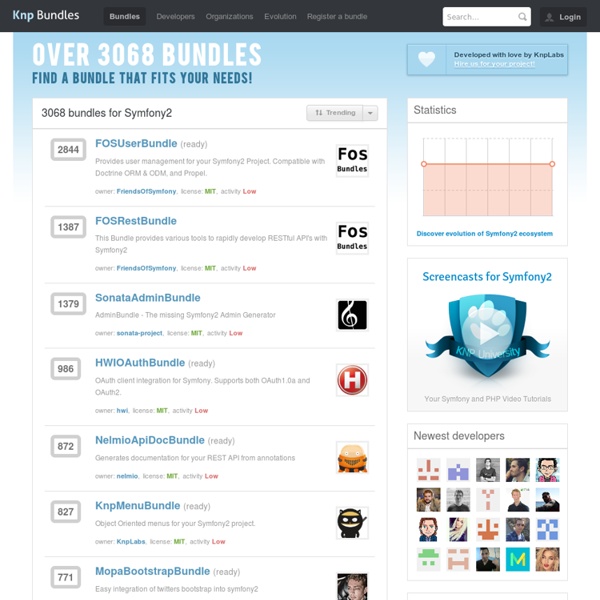



getRaw escaping problems Scene from "Disney's Adventures of the Gummi Bears" by Jymn Magon & Art Vitello (introduced in 1985) Probably most of us have encountered difficulties connected with default escaping mechanism in symfony templates. Yes, it is frustrating at times. FilePermissionsACLs POSIX Access Control Lists (ACLs) are more fine-grained access rights for files and directories. An ACL consists of entries specifying access permissions on an associated object. ACLs can be configured per user, per group or via the effective rights mask. These permissions apply to an individual user or a group, and use the same as rwx found in regular permissions. For an explanation of rwx, see FilePermissions
Configuration à l'exécution Le comportement de ces fonctions est affecté par la configuration dans le fichier . Bien que la configuration par défaut d'APC soit suffisante pour la plupart des installations, les utilisateurs avancés devraient affiner certains paramètres. Il y a deux décisions importantes que vous devez prendre lorsque vous configurez APC. Tout d'abord, quelle quantité de mémoire partagée va être allouée à APC, et ensuite, si vous voulez qu'APC vérifie à chaque requête si un fichier a été modifié. Les deux directives de configuration correspondantes sont apc.shm_size et apc.stat. Lisez avec attention la section suivante sur ces deux directives de configuration.
Welcome to Doctrine 2 ORM’s documentation! — Doctrine 2 ORM 2 documentation The Doctrine documentation is comprised of tutorials, a reference section and cookbook articles that explain different parts of the Object Relational mapper. Doctrine DBAL and Doctrine Common both have their own documentation. Getting Help If this documentation is not helping to answer questions you have about Doctrine ORM don’t panic. An example of Symfony2 CollectionType form field prototype on havvg's playground While working an a multi-step form with multiple CollectionType in it, I came across the issue requiring a generic solution for handling allow_add and allow_delete on a collection. As there is no entry on the allow_delete part in the Symfony2 documentation itself, this solution may not be the best way to do it. If you got other solutions on this topic, let me know! The form types <?php namespace Acme\Bundle\BlogBundle\Form\Type; use Symfony\Component\Form\FormBuilder;use Symfony\Component\Form\AbstractType; class PostType extends AbstractType{ public function buildForm(FormBuilder $builder, array $options) { $builder ->add('title') ->add('content', 'textarea') ->add('tags', 'collection', array( 'type' => new TagType(), 'allow_add' => true, 'allow_delete' => true, 'prototype' => true, 'prototype_name' => 'tag__name__', 'options' => array( // options on the rendered TagTypes ), )) ; } public function getName() { return 'post'; }}
Commencer à développer avec le framework symfony Le web est un environnement est en pleine mutation. De nombreuses technologies et outils font leur apparition et nous proposent tous les jours de plus en plus d'interactivités dans nos pages web (« Atlas », script.aculo.us, Adobe Integrated Runtime…). Toutes ces technologies transforment nos chers navigateurs en véritable plateformes. Cependant, on oublie souvent en voyant toutes ces technologies que l'évolution se situe aussi du côté du serveur. Le langage PHP lui aussi témoigne de ces profonds changements dans notre manière de développer. Assertions Une assertion est un test sur les caractères suivants ou précédents celui qui est en cours d'étude. Ce test ne consomme par de caractère (ie, on ne déplace pas le pointeur de caractères). Les assertions simples sont codées avec \b, \B, \A, \Z, \z, ^ et $, et sont décrites précédemment. Il existe cependant des types d'assertions plus complexes, codées sous la forme de sous-masques.
Resources/fr_FR SensioLabsWorldSLW Blackfire.io Blackfire.io: Fire up your PHP apps performance Hands-on with the Symfony2 Framework Learn symfony: a Beginner's Tutorial With the release of symfony 1.0, it’s time for those who haven’t tried it yet to see what’s inside this beautiful framework. Stable, fully documented, and released under the open-source MIT license, symfony is used by hundreds of web sites, including some very large ones (Yahoo! Bookmarks, with its 20 million-strong user base, is built with symfony). If you haven’t taken the time to look at the introductory screencasts on the symfony project website, this simple tutorial will lead you through the basics. The best way to learn and understand symfony is to use it, so this article will lead you through the creation of a photo album application with this framework.
A Coder's Life YAML based CSS layouts Symfony Components - Standalone libraries for PHP Beside being a full-stack framework, Symfony is also a set of decoupled and standalone components. What is a Component? Symfony Components implement common features needed to develop websites. Symfony deployment Cheat Sheet